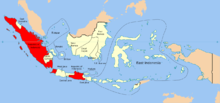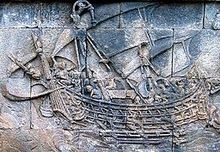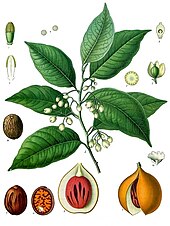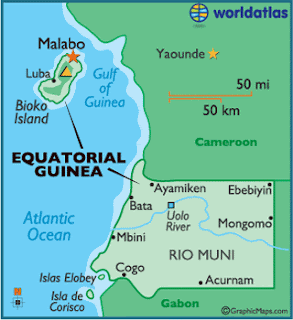The Battle of
Surabaya was fought between pro-independence Indonesian soldiers and militia
against British and Dutch troops as a part of the Indonesian National Revolution.
The peak of the battle was in November 1945. Despite fierce resistance, British
Indian troops managed to conquer Surabaya, the second-largest city in Indonesia, on
behalf of the Netherlands. The battle was the heaviest single battle of the
revolution and became a national symbol of Indonesian resistance. Considered a heroic effort by Indonesians, the battle helped galvanise
Indonesian and international support for Indonesian independence. 10 November is
celebrated annually as Heroes' Day (Hari Pahlawan).
By the time the Allied
forces arrived at the end of October 1945, the pemuda ('youth')
foothold in Surabaya City was described as "a strong unified fortress". Ferocious fighting erupted when 6,000 Indian troops landed in the city to
evacuate European internees. Following the killing on 30 October of the British
commander, Brigadier A. W. S. Mallaby, the
British retaliated with a punitive sweep that began on 10 November, under the
cover of air attacks. Although the European forces largely captured the city in
three days, the poorly armed Republicans fought for three weeks, and thousands
died as the population fled to the countryside.
Despite the military
defeat suffered by the Republicans and a loss of manpower and weaponry that
would severely hamper Republican forces for the rest of the revolution, the
battle and defence mounted by the Indonesians galvanised the nation in support
of independence and helped garner international attention. For the Dutch, it
removed any doubt that the Republic was not simply a gang of collaborators
without popular support. It also had the effect of convincing Britain that
wisdom lay on the side of neutrality in the revolution; within a few years, in fact, Britain would support the Republican cause in the
United Nations
Death of Brigadier Mallaby
On 30 October 1945,
Brigadier A. W. S. Mallaby, the British
brigade commander in Surabaya, was travelling about Surabaya to spread the news
about the new agreement to his troops. When his car approached the British
troops' post in the International building near the Jembatan Merah ("Red
Bridge"), his car was surrounded by Indonesian Republican militia. Shortly
after, Mallaby was shot and killed by the militia under confused
circumstances.
Captain R.C. Smith,
who was in the stationary car, reported that a young Republican shot and killed
Mallaby after a short conversation. Smith then reported throwing a grenade from
the car in the direction of where he thought the shooter had hidden. Although he
was not sure whether or not it hit its target, the explosion caused the back
seat of the car to ignite. Other accounts, according to the same source, stated that it was the explosion and not a shooter that killed Mallaby.
Regardless of its exact details, Mallaby's death was a significant turning point
for the hostilities in Surabaya, and a catalyst for the battle to come. The
British ordered an Indonesian surrender, and on 10 November they rolled out a
large retaliatory attack
Linggadjati Agreement
The Linggadjati
Agreement, brokered by the British and concluded in November 1946, saw the
Netherlands recognise the Republic as the de facto authority over Java,
Madura, and Sumatra.
Both parties agreed to the formation of the United States of Indonesia by 1
January 1949, a semi-autonomous federal state with the monarch of the Netherlands at its
head. The Republican-controlled Java and Sumatra would be one of its states,
alongside areas that were generally under stronger Dutch influence, including
southern Kalimantan, and the "Great East", which consisted of Sulawesi, Maluku,
the Lesser
Sunda Islands, and Western New Guinea. The Central National
Committee of Indonesia (KNIP) did not ratify the agreement until February 1947,
and neither the Republic nor the Dutch were satisfied with it.[2] On 25
March 1947 the Lower House
of the Dutch parliament ratified a stripped down version of the treaty, which
was not accepted by the Republic.[34] Both
sides soon accused the other of violating the agreement
[edit] Renville Agreement
Main article: Renville
Agreement
The United Nations
Security Council brokered the Renville Agreement in an attempt to rectify the
collapsed Linggarjati Agreement. The agreement was ratified in January 1948 and
recognised a cease-fire along the so-called 'Van Mook line'; an
artificial line which connected the most advanced Dutch positions.[38] Many
Republican positions, however, were still held behind the Dutch lines. The
agreement also required referenda to be held on the political future of the
Dutch held areas. The apparent reasonableness of Republicans garnered much
important American goodwill.
Diplomatic efforts
between the Netherlands and the Republic continued throughout 1948 and 1949.
Political pressures, both domestic and international, hindered Dutch attempts at
goal formulation. Similarly Republican leaders faced great difficulty in
persuading their people to accept diplomatic concessions. By July 1948
negotiations were in deadlock and the Netherlands pushed unilaterally towards
Van Mook’s federal Indonesia concept. The new federal states of South Sumatra
and East Java were created, although neither had a viable support base. The Netherlands
set up the Bijeenkomst voor Federaal Overleg (BFO) (or Federal Consultative Assembly), a
body comprising the leadership of the federal states, and charged with the
formation of a United States of Indonesia and an
interim government by the end of 1948. The Dutch plans, however, had no place
for the Republic unless it accepted a minor role already defined for it. Later
plans included Java and Sumatra but dropped all mention of the Republic. The
main sticking point in the negotiations was the balance of power between the
Netherlands High Representative and the Republican forces.
Mutual distrust between
the Netherlands and the Republic hindered negotiations. The Republic feared a
second major Dutch offensive, while the Dutch objected to continued Republican
activity on the Dutch side of the Renville line. In February 1948 the Siliwangi
Battalion of the Republican Army, led by Nasution, marched from West Java to Central Java; the
relocation was intended to ease internal Republican tensions involving the
Battalion in the Surakarta area. The Battalion, however, clashed with Dutch
troops while crossing Mount
Slamet, and the Dutch believed it was part of a systematic troop movement
across the Renville Line. The fear of such incursions actually succeeding, along
with apparent Republican undermining of the Dutch-established Pasundan state and
negative reports, led to the Dutch leadership increasingly seeing itself as
losing control.
Internal turmoil
Social revolutions
The so-called 'social
revolutions' following the independence proclamation were challenges to the
Dutch-established Indonesian social order, and to some extent a result of the
resentment against Japanese-imposed policies. Across the country, people rose up
against traditional aristocrats and village heads and attempted to exert popular
ownership of land and otr resources. The majority of the social revolutions ended quickly; in most cases the
challenges to the social order were quashed]
A culture of violence
rooted in the deep conflicts that split the countryside under Dutch rule would
repeatedly erupt throughout the whole second half of the twentieth century. The term 'social revolution' has been applied to a range of mostly violent
activities of the left that included both altruistic attempts to organise real
revolution and simple expressions of revenge, resentment and assertions of
power. Violence was one of the many lessons learned during the Japanese
occupation, and figures identified as 'feudal', including kings, regents, or simply the
wealthy, were often attacked, sometimes beheaded, and rape became a weapon
against 'feudal' women. In
the coastal sultanates of Sumatra and Kalimantan, for example, sultans and others whose authority had been shored-up by
the Dutch, were attacked as soon as Japanese authority left. The secular local
lords of Aceh, who had been the foundation
of Dutch rule, were executed, although most of Indonesia's sultanates fell back
into Dutch hands.
Most Indonesians lived
in fear and uncertainty, particularly a significant proportion of the population
who supported the Dutch or who remained under Dutch control. The popular
revolutionary cry 'Freedom or Death' was often interpreted to justify killings
under claimed Republican authority. Traders were often in particularly difficult
positions. On the one hand, they were pressured by Republicans to boycott all
sales to the Dutch; on the other hand, Dutch police could be merciless in their
efforts to stamp out smugglers on which the Republican economy depended. In some
areas, the term kedaulatan rakyat ('exercising the sovereignty of the
people') – which is mentioned in the preamble of the Constitution and used by
pemuda to demand pro-active policies from leaders – came to be used not
only in the demanding of free goods, but also to justify extortion and robbery.
Chinese merchants, in particular, were often forced to keep their goods at
artificially low prices under threat of death.
Communist and Islamist insurgencies
Main articles: Madiun Affair and Darul Islam
(Indonesia)
On 18 September 1948 an
'Indonesian Soviet
Republic' was declared in Madiun, east of Yogyakarta, by members of the PKI and
the Indonesian Socialist Party (PSI).
Judging the times as right for a proletarian uprising, they intended it to be a
rallying centre for revolt against "Sukarno-Hatta, the slaves of the Japanese
and America".[13]
Madiun however was won back by Republican forces within a few weeks and the
insurgency leader, Musso, killed. RM Suryo, the
governor of East Java, several police officers and religious leaders were killed
by the rebels. This ended a distraction for the revolution, and
it turned vague American sympathies based on anti-colonial sentiments into
diplomatic support. Internationally, the Republic was now seen as being
staunchly anti-communist
and a potential ally in the emerging global Cold War between the American-led 'free world' and the
Soviet-led bloc.
Members of the
Republican Army who had come from Indonesian Hizbullah felt betrayed by
Indonesian Government. In May 1948, they declared a break-away regime, the
Negara Islam Indonesia (Indonesian Islamic State), better known as
Darul Islam. Led by an Islamic mystic, Sekarmadji Maridjan
Kartosuwirjo, Darul Islam sought to establish Indonesia as an Islamic theocracy. At the
time, the Republican Government did not respond as they were focused on the
threat from the Dutch. Some leaders of Masjumi sympathised with the rebellion. After the
Republic regained all territories in 1950, the government took the Darul
Islam threat seriously, especially after some provinces declared their
joining of Darul Islam. The rebellion was put down in 1962.
Transfer of sovereignty
Millions upon millions flooded the sidewalks, the roads. They were crying, cheering, screaming "...Long live Bung Karno..." They clung to the sides of the car, the hood, the running boards. They grabbed at me to kiss my fingers. Soldiers beat a path for me to the topmost step of the big white palace. There I raised both hands high. A stillness swept over the millions. "Alhamdulillah – Thank God," I cried. "We are free"
—Sukarno's recollections of independence achieved.
The resilience of
Indonesian Republican resistance and active international diplomacy set world
opinion against the Dutch efforts to re-establish their colony.[46] The
second 'police action' was a diplomatic disaster for the Dutch cause. The newly
appointed United States Secretary of
State Dean Acheson
pushed the Netherlands government into negotiations earlier recommended by the
United Nations but until then defied by the Netherlands. The Dutch–Indonesian
Round Table Conference was held in The Hague from 23 August 1949 to 2
November 1949 between the Republic, the Netherlands, and the Dutch-created
federal states. The Netherlands agreed to recognise Indonesian sovereignty over
a new federal state known as the 'United States of Indonesia' (RUSI).
It would include all the territory of the former Dutch East Indies with the
exception of Netherlands New Guinea; sovereignty over
which it was agreed would be retained by the Netherlands until further
negotiations with Indonesia. The other difficult issue to which Indonesia gave
concessions was Netherlands East Indies debt. Indonesia agreed to responsibility
for this sum of £4.3 billion, much of which was directly attributable to Dutch
attempts to crush the revolution. Sovereignty was formally transferred on 27
December 1949, and the new state was immediately recognised by the United States
of America.

The United States of Indonesia, December
1949 – the Republic of Indonesia is shown in red
Republican-controlled
Java and Sumatra together formed a single state in the sixteen-state RUSI
federation, but accounted for almost half its population. The other fifteen
'federal' states had been created by the Netherlands since 1945. These states
were dissolved into the Republic over the first half of 1950. An abortive
anti-Republic coup in Bandung and Jakarta by Westerling's Legion of Ratu
Adil (APRA) on 23 January 1950 resulted in the dissolution of the populous
Pasundan state in West Java, thus
quickening the dissolution of the federal structure. Colonial soldiers, who were
largely Ambonese, clashed with Republican troops in Makassar during the Makassar Uprising in April 1950. The
predominantly Christian Ambonese were from one of the few regions with pro-Dutch
sentiments and they were suspicious of the Javanese Muslim-dominated Republic,
whom they unfavourably regarded as leftists. On 25 April 1950, an independent Republic
of South Maluku (RMS) was proclaimed in Ambon but this was suppressed by
Republican troops during a campaign from July to November. With the state of
East Sumatra now being the only federal state remaining, it too folded and fell
in line with the unitary Republic. On 17 August 1950, the fifth anniversary of
his declaration of Indonesian independence, Sukarno proclaimed the Republic of Indonesia as a unitary state.
Impacts
Although there is no
accurate account of how many Indonesians died, they died in far greater numbers
than their enemies, and many died at the hands of other Indonesians. Estimates
of Indonesian deaths in fighting range from 45,000 to 100,000 and civilian
casualties exceeded 25,000 and may have been as high as 100,000. A
total of 1,200 British soldiers were killed or went missing in Java and Sumatra
in 1945 and 1946, most of them Indian soldiers. More than 5,000
Dutch soldiers lost their lives in Indonesia between 1945 and 1949. Many more
Japanese died; in Bandung alone, 1,057 died, only half of whom died in actual
combat, the rest killed in rampages by Indonesians. Tens of thousands of Chinese
and Eurasians were killed or left homeless, despite the fact that many Chinese
supported the revolution. Seven million people were displaced on Java and
Sumatra.
The revolution had
direct effects on economic conditions; shortages were common, particularly food,
clothing and fuel. There were in effect two economies – the Dutch and the
Republican – both of which had to simultaneously rebuild after World War II and
survive the disruptions of the revolution. The Republic had to set up all
necessities of life, ranging from 'postage stamps, army badges, and train
tickets' whilst subject to Dutch trade blockades. Confusion and ruinous
inflationary surges resulted from competing currencies; Japanese, new Dutch
money, and Republican currencies were all used, often concurrently.
Indonesian independence
was secured through a blend of both diplomacy and force. Despite their
ill-discipline raising the prospect of anarchy, without pemuda
confronting foreign and Indonesian colonial forces, Republican diplomatic
efforts would have been futile. The revolution is the turning point of modern Indonesian
history, and it has provided the reference point and validation for the
country’s major political trends that continue to the present day. It gave
impetus to communism in the country, to militant nationalism, to Sukarno's 'guided democracy', to
political Islam, the origins of the Indonesian army and its role in Indonesian
power, the country's constitutional arrangements, and the centralism of power in
Indonesia.
The revolution
destroyed a colonial administration ruled from the other side of the world, and
dismantled with it the raja, seen by many as obsolete and powerless.
Also, it relaxed the rigid racial and social categorisations of colonial
Indonesia. Tremendous energies and aspirations were created amongst Indonesians;
a new creative surge was seen in writing and art, as was a great demand for
education and modernisation. It did not, however, significantly improve the
economic or political fortune of the population’s poverty-stricken peasant
majority; only a few Indonesians were able to gain a larger role in commerce,
and hopes for democracy were dashed within a decade






























